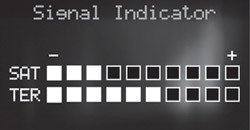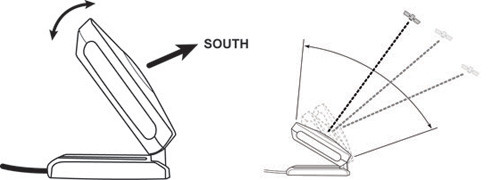Step 1: Do You Live in a Major Metropolitan Area?
Step 1 will provide quick instructions to determine if you can receive the terrestrial repeater signal. Otherwise, begin with Step 2. SiriusXM has terrestrial repeaters in major metropolitan areas. These ground-based repeaters transmit the SiriusXM signal into your home or office, eliminating the need to aim the antenna at a satellite. Follow these instructions for a quick test to see if you can receive the terrestrial signal.
1. Place the antenna in a convenient location inside of your home.
2. Open the antenna clamshell so that it is halfway between the horizontal and vertical positions as shown.
3. Connect the antenna cable to the ANT connection on the Radio or Home Dock.
4. Turn your SiriusXM Radio ON and access the Signal Indicator (or Antenna Aiming) screen. (Consult your Radio's User Guide for instructions on accessing the screen.)
The Signal Indicator screen shows the strength of both the satellite (SAT) signal and the terrestrial (ground) (TER) signal. The strength of the terrestrial (ground) signal may vary, or there may be none if you are not in a major metropolitan area.
If you're receiving a terrestrial (ground) (TER) signal, try experimenting with the antenna to get a feel for the reception in your location. Move the antenna around the room, from room to room, and aim it toward different windows. In major metropolitan areas, you might find that you get great reception in several locations without worrying too much about aim and placement. If you find a location where there's good terrestrial signal strength, place the antenna there. The installation is complete.
Step 2: Place the Antenna
Find a suitable window in your home or office that faces south.
- This window needs to have a clear, unobstructed view of the sky.
- There should NOT be any blinds or curtains between the antenna and the glass window pane.
- There should NOT be any metal screens or bars on the window.
- There should NOT be any buildings, shrubs, trees, roof overhangs, or anything else obstructing the antenna's view of the south sky (see below).
Place the antenna on the windowsill of a suitable window that faces south. Not sure which way is south? Think about where the sun rises (in the east) and sets (in the west). Then stand so that east is to your left and you'll be facing south.
Note: If placing the antenna on the windowsill results in the antenna directly facing the window's frame, place a book or other flat object under the antenna to prop the antenna up so that it is facing the glass window pane.
The surface of the antenna shown in gray should be facing the window pane and should be pointed south.
Step 3: Aim the Antenna
Open the antenna clamshell so that it is halfway between the horizontal and vertical positions as shown.
Orient the antenna so that the shaded surface shown is facing the window.
Step 4: Connect the Antenna to Your SiriusXM Radio or Home Dock
Connect the antenna cable to the ANT connection on the Radio or Home Dock.
Step 5: Verify Signal Reception
Turn your SiriusXM Radio ON and access the Signal Indicator (or Antenna Aiming) screen. (Consult your Radio's User Guide for instructions on accessing the screen.) The Signal Indicator screen shows the strength of both the satellite (SAT) signal and the terrestrial (ground) (TER) signal (if available).
We need to fine tune the aim of the antenna to optimize signal reception. While watching the Signal Indicator screen, rotate the antenna left or right in small increments, as shown, until the highest possible satellite (SAT) signal strength is achieved.
While continuing to watching the Signal Indicator screen, adjust the tilt angle in small increments, toward the horizontal or vertical positions, as shown, until the highest possible satellite (SAT) signal strength is achieved. The installation is complete.
Signal Distribution Accessories For You to Consider
50 ft. Antenna Extension Cable: If the cable attached to the antenna is not long enough, you can use a 50' long antenna extension cable (sold separately) to extend the antenna cable.














